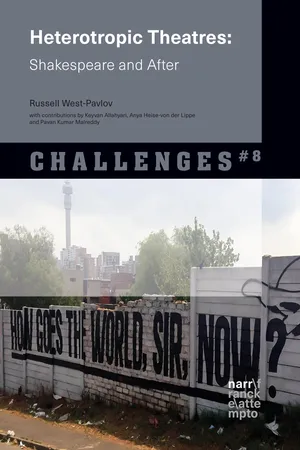
- English
- ePUB (mobile friendly)
- Available on iOS & Android
About this book
This book seeks to elaborate a theory of 'troping' that expands thepurview of linguistic work and agency, parsing its transformative work beyond the limits usually set by theories of language. It registers a sea-change in the theorization of theatrical art from representation to intervention. The book thereby seeks to lay bare the activity of language as a heterotropology. It focuses on early modern theatre from Shakespeare (Hamlet, Macbeth, Romeo and Juliet, Troilus and Cressida) and other theatrical forms of the same era (the Court Masque, dramas by Ford or Johnson) through to the Restoration; it also reads a number of contemporary avatars of Shakespearean texts from Stoppard to Jones, and of early modern and postmodern performance spaces such as the New Globe Theatre. In a dozen readings of early modern theatre it asks how the remarkable energy and social purchase ascribed to theatrical language by contemporary commentators can be reconceptualized, mobilized anew and thus harnessed for our own turbulent times.
Frequently asked questions
- Essential is ideal for learners and professionals who enjoy exploring a wide range of subjects. Access the Essential Library with 800,000+ trusted titles and best-sellers across business, personal growth, and the humanities. Includes unlimited reading time and Standard Read Aloud voice.
- Complete: Perfect for advanced learners and researchers needing full, unrestricted access. Unlock 1.4M+ books across hundreds of subjects, including academic and specialized titles. The Complete Plan also includes advanced features like Premium Read Aloud and Research Assistant.
Please note we cannot support devices running on iOS 13 and Android 7 or earlier. Learn more about using the app.
Information
Table of contents
- Cover
- Title
- Copyright
- Contents
- PREFACE ‘How goes the world, sir, now?’
- INTRODUCTION Troping the Early Modern, Re-Troping the Present (Hamlet)
- CHAPTER 1 Heterotropologies: Towards a theory of the theatrical trope (Hamlet and chiasmus)
- CHAPTER 2 The Contemporary Transformations of Spatial Experience – and their Fall-Out: Rosencrantz and Guildenstern are Dead and Hamlet
- CHAPTER 3 The Court, the Masque, and Friction
- CHAPTER 4 Cultural Catachresis, Cultural Memory and the New Globe Theatre
- CHAPTER 5 Feminine Sexuality, Incest and Gender Coercion in Ford’s ’Tis Pity She’s a Whore
- CHAPTER 6 Un-Fashioning Gendered Bodies on the Restoration Stage (Etheredge’s Man of Mode)
- CHAPTER 7 Time, Space, Emulation and Violence in Troilus and Cressida
- CHAPTER 8 Deadly Affect and Moribund ‘Epochality’ in Troilus and Cressida
- CHAPTER 9 ‘Have you a mind to sink?’ – Imagining Liminal and Oceanic Spatiality in King Lear, Hamlet and The TempestAnya Heise-von der Lippe
- CHAPTER 10 Shakespeare’s Aquatopia: The Tempest in an Age of Blue Humanities Pavan Kumar Malreddy
- CHAPTER 11 Postcolonial Texts, Colonial Intertexts and their Imbrications – Macbeth and the Sonnets in Gail Jones’s Sorry
- CHAPTER 12 Macbeth, Auerbach, Vladislavić – Figural readings and temporalities of crisis in Johannesburg
- CHAPTER 13 Exceptional Shakespeare: (Mediated) Rendition and the Carceral Middle East in Iqbal Khan’s OthelloKeyvan Allahyari
- CODA What is my contemporary? (Romeo and Juliet)
- Bibliography
- Acknowledgements
- Footnotes